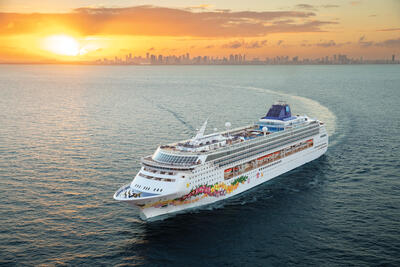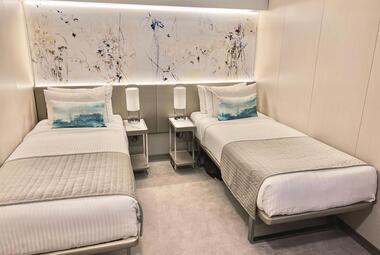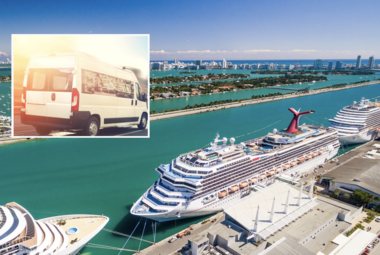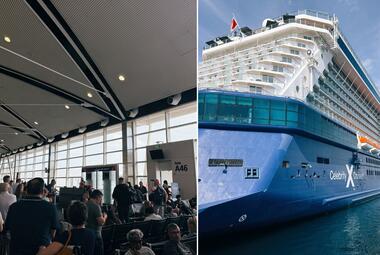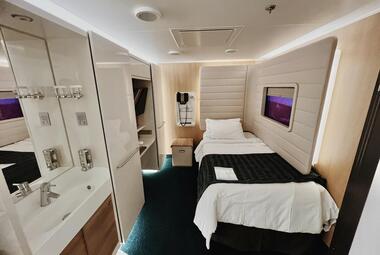While mega-ships like Icon of the Seas offer an unparalleled experience with their vast array of amenities and entertainment options, smaller ships have their own unique charm.
Though you won't find roller coasters, water slides, or countless dining options, the intimate atmosphere, affordable fares, and destination-focused itineraries create a relaxed and personal cruising experience.
Fewer crowds lead to a greater opportunity to connect with passengers and crew, and instead of focusing on the ship's amenities, you can gear up for long days ashore, immersing yourself in the off-the-beaten-path destinations on your itinerary.
Still not convinced? Here are 7 advantages to sailing on small cruise ships.
Intimacy
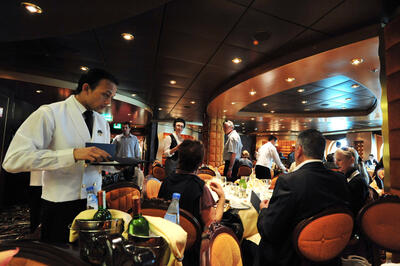
Today's biggest cruise ships can hold upwards of 7,600 passengers. Even with more crew than smaller ships, providing personalized and attentive service is difficult.
However, crew members on small cruise ships are more likely to remember your face after just one or two interactions. With fewer guests to attend to, crew members can offer more personalized service, as they can quickly understand individual preferences.
Not only that, but the low-key nature of small ships makes it easier to meet other passengers. You'll see the same faces repeatedly throughout the sailing, whether at dinner, walking into a show, on the lido deck, or disembarking in port. This fosters a sense of community that's often lacking on mega cruise ships.
Read more: 9 most important crew members to meet on your cruise ship
Unique itineraries
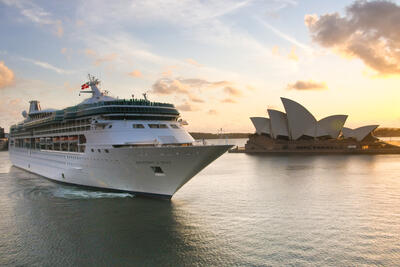
While many see larger ships as a destination in and of themselves, other cruisers are more destination-focused. Smaller ships can navigate into ports of call that cannot accommodate mega-ships, giving you more variety when it comes to itineraries.
Though the Caribbean islands of St. Thomas and St. Maarten are undeniably beautiful, there are many other interesting places to explore. For instance, maybe you're interested in exploring Africa. While cruises aren't as plentiful as to the Caribbean or Bahamas, you'll find itineraries on smaller ships, such as Norwegian Sky.
Moreover, expedition ships—while costly—can provide guests a more immersive experience in port. While larger ships can sail through Antarctica, for example, guests cannot go ashore due to regulations prohibiting more than 100 passengers on land at any time.

Plus, expedition ships typically have knowledge guides onboard to give enriching lectures and come ashore with guests, leading hikes and other tours.
Exploring less-visited destinations adds a sense of adventure to your cruise. From the beaches of remote Pacific islands to ancient ruins of historical sites and vibrant cultures of small coastal towns, small cruise ships provide an experience that's not available on large vessels.
Read more: I went on one of the weirdest cruise itineraries possible
Easier to navigate
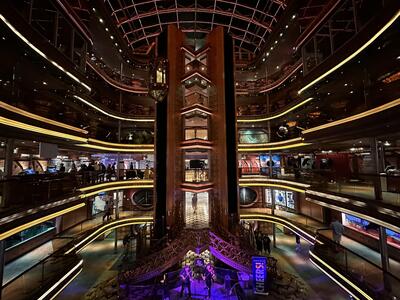
Massive cruise ships can feel like labyrinths with seemingly endless hallways and corridors. If you didn't take time to glance at the deck plan before embarkation day, it may take you a few days to learn the lay of the land.
Smaller ships, on the other hand, are typically pretty straightforward. With fewer decks to navigate, it is easier to familiarize yourself with the ship's amenities.
Plus, you'll spend less time walking from Point A to Point B, meaning you can quickly access your favorite spots onboard, from the Main Dining Room to the theater.
More adult-focused

Families with young children may not see this as an advantage; however, if your children are grown or you're in the mid-20s and childless (like me!), you may want to seek out a cruise ship less likely to be overrun by kids.
Since small ships have less real estate, there are fewer activities for children onboard. You won't find water slides, rock walls, ice skating rinks, roller coasters, etc. Instead, the experience is more tailored to adult interests, like upscale bars and enrichment lectures.
While that's not to say you won't find children onboard, especially if you're sailing during spring break or the winter holidays, families are more likely to choose a ship with more activities to keep everyone entertained.
Read more: 13 Best Adult Cruise Lines
Fewer opportunities for onboard spending

Unfortunately, mainstream cruise lines are known for nickel and diming their passengers. From specialty restaurants to extra-cost activities, some passengers feel like the experience is less inclusive than it used to be during a more traditional era of raising.
Newer—and larger—ships have seemingly endless options to tempt guests to spend additional money. Royal Caribbean's Utopia of the Seas, for example, is the only ship in the fleet with an immersive train car specialty restaurant. Similarly, guests onboard Princess Cruises' Sun Princess can enter a world of magic at Spellbound by Magic Castle.
Select ships within Norwegian's Breakaway and Prima Class have go-kart tracks on the top deck. However, the activity isn't included in the cost of your cruise. You'll have to pay $15 per person to race friends and family. Smaller ships don't have the space for such amenities, leading you to have fewer opportunities to be tempted to spend money.
Read more: 16 hidden cruise ship extra charges you should know about

While you can still browse the cruise line's store and debate bringing home duty-free spirits, fewer specialty restaurants and extra-cost activities means it's easier to keep your onboard spending to a minimum.
Moreover, if you opt to sail on a luxury or expedition ship, the fares tend to be more inclusive. Rather than worrying about pricing out drink packages, Wi-Fi, and excursions, many of these traditional add-ons are included in the cost of your cruise.
Read more: Watch out for these 8 fees and 1 smart hack that could make your cruise vacation more expensive
Smaller passenger capacity

If you aren't a fan of crowds, opting for a smaller cruise ship can result in a more relaxing experience.
Ships like Grandeur of the Seas can hold—at maximum capacity—around 2,440 guests. In comparison, Icon of the Seas and Carnival Celebration can accommodate over 6,400 passengers.
Sharing the ship with fewer people often means less congestion in public spaces. It's typically easier to find a lounge chair on the pool deck, and navigating the ship is easier without the hustle and bustle that can come with larger vessels. Have you ever waited ten minutes or longer for an elevator? It can be annoying!
Affordability
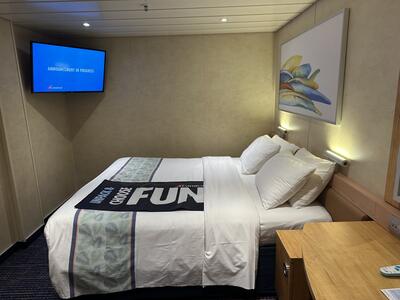
Sailing on a small ship can be a great way to cruise on a budget. A 6-night cruise onboard Carnival Paradise, one of the smallest ships in Carnival's fleet, starts at $599 per person, whereas a weeklong cruise on Carnival Jubilee, Carnival's flagship, costs at least $769 per person.
Not only that but there are more cabins for budget-conscious travelers. Bigger ships place an emphasis on balcony cabins, which come with a higher price tag than inside cabins. Carnival Elation, for example, has 1,095 cabins. While passengers can splurge on a suite or one of the few standard balconies, 39% of staterooms are interior cabins with no natural light.
Carnival Celebration, in comparison, has 846 interior staterooms, which equates to 31% of its total inventory. The difference means that smaller ships like Carnival Elation offer a higher percentage of budget-friendly cabins, making it easier for cruisers to find affordable fares.
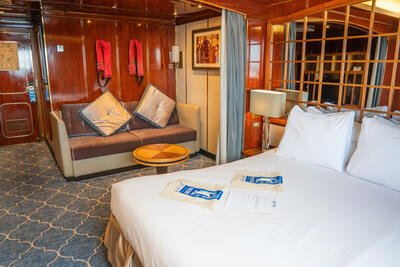
This trend only applies to mainstream cruise lines, though. If you want to cruise on an expedition ship or with a luxury line like Regent Seven Seas, you'll pay thousands more, even for the cheapest stateroom onboard.
Planning a cruise? Here are some other helpful guides:


